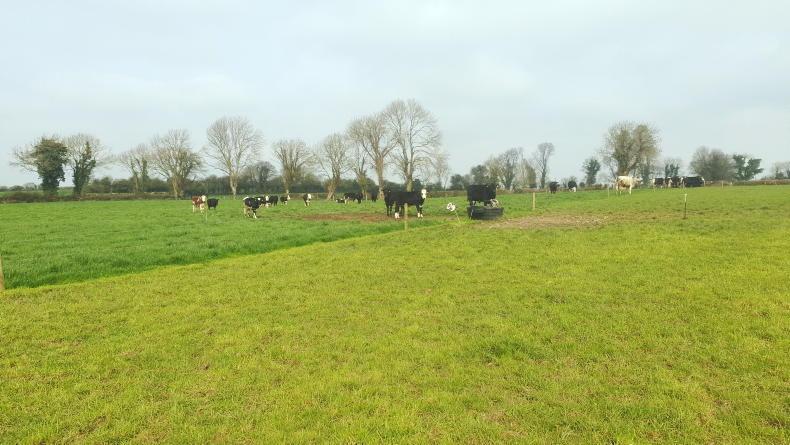Yearling cattle on the Thrive demonstration farm in Cashel, Co Tipperary, are at grass again for the last three weeks.
After being rehoused during the second week of March for almost a week due to poor weather conditions, things have improved vastly ground condition-wise, especially over the last 10 days.
This has meant that farmer John Hally has been able to push stock that bit harder to achieve good graze-outs, hitting 4cm post-grazing sward height.
This is really important to do, as it sets the ground up for grazing throughout the year.

Improved ground conditions means graze outs have been excellent.
When ground conditions were that bit trickier, John was having to move cattle on perhaps a day earlier than we would have liked, in order to avoid any poaching.
Low grass demand
It can be difficult to manage grass on farms solely operating dairy beef systems in early spring.
This is because yearling cattle are only averaging around 360kg, while calves are either indoors for rearing or beginning to move to grass with a very low daily grass demand.
Therefore, grass supply can quickly outstrip demand once growth takes off in spring.
This problem is compounded where silage ground needs to be grazed in spring ahead of closing for first cut.
Last year on the demo farm, cattle were turned out to graze silage ground on 10 March.
However, due to a low demand for grass, stock were still on silage ground up to the middle of April.
This meant that grazing ground was going strong by the time the cattle reached it. As a result, we were cutting surplus grass off the pasture ground by late April.
Grazing silage ground
To avoid having the same problem this year, silage ground was grazed last before housing for winter. The weanlings grazed this ground right up until early November.
This meant it did not have a heavy cover of grass in spring and did not need to be grazed post-closing for silage.
It also meant that the grazing ground could be grazed earlier in spring to try to keep on top of grass supply.
In saying this, a later turnout date this year, combined with having to rehouse cattle for a week in March, has left us with a large supply of grass on the grazing ground once again.
However, the situation would have been much worse if we had to graze the silage ground first this spring.
Read more
Thrive: beware of pneumonia on the rise
Watch: common issues in the calf-rearing shed
Tetany issues on beef farms as weather takes a turn
Yearling cattle on the Thrive demonstration farm in Cashel, Co Tipperary, are at grass again for the last three weeks.
After being rehoused during the second week of March for almost a week due to poor weather conditions, things have improved vastly ground condition-wise, especially over the last 10 days.
This has meant that farmer John Hally has been able to push stock that bit harder to achieve good graze-outs, hitting 4cm post-grazing sward height.
This is really important to do, as it sets the ground up for grazing throughout the year.

Improved ground conditions means graze outs have been excellent.
When ground conditions were that bit trickier, John was having to move cattle on perhaps a day earlier than we would have liked, in order to avoid any poaching.
Low grass demand
It can be difficult to manage grass on farms solely operating dairy beef systems in early spring.
This is because yearling cattle are only averaging around 360kg, while calves are either indoors for rearing or beginning to move to grass with a very low daily grass demand.
Therefore, grass supply can quickly outstrip demand once growth takes off in spring.
This problem is compounded where silage ground needs to be grazed in spring ahead of closing for first cut.
Last year on the demo farm, cattle were turned out to graze silage ground on 10 March.
However, due to a low demand for grass, stock were still on silage ground up to the middle of April.
This meant that grazing ground was going strong by the time the cattle reached it. As a result, we were cutting surplus grass off the pasture ground by late April.
Grazing silage ground
To avoid having the same problem this year, silage ground was grazed last before housing for winter. The weanlings grazed this ground right up until early November.
This meant it did not have a heavy cover of grass in spring and did not need to be grazed post-closing for silage.
It also meant that the grazing ground could be grazed earlier in spring to try to keep on top of grass supply.
In saying this, a later turnout date this year, combined with having to rehouse cattle for a week in March, has left us with a large supply of grass on the grazing ground once again.
However, the situation would have been much worse if we had to graze the silage ground first this spring.
Read more
Thrive: beware of pneumonia on the rise
Watch: common issues in the calf-rearing shed
Tetany issues on beef farms as weather takes a turn







 This is a subscriber-only article
This is a subscriber-only article












SHARING OPTIONS: